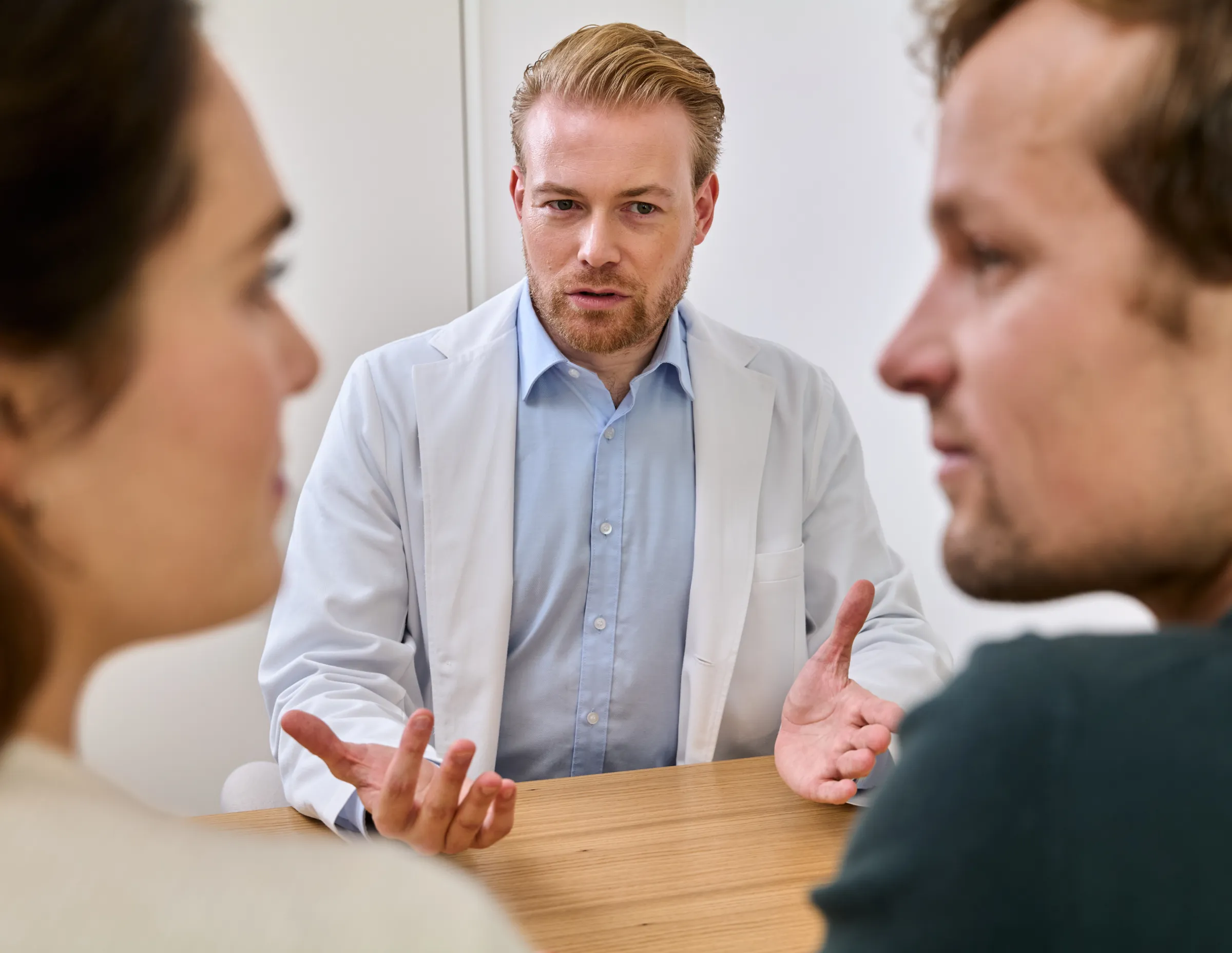How are sperm cells formed? What makes good sperm cells? And how have sperm changed in recent decades?
How are sperm cells formed? What makes good sperm cells? And how have sperm changed in recent decades?
Millions of sperm (also called spermatozoa) are produced every day in the male reproductive organs. Sperm cells (also known as gametes or germ cells) carry the male genetic material to fertilise a female egg (ovum).
The sperm production cycle
From the onset of puberty, the pituitary gland secretes follicle-stimulating hormone (FSH), luteinising hormone (LH) and testosterone. These hormones cause sperm to form in the seminiferous tubules, which are located in the testes. This process is called spermatogenesis.
Spermatogenesis is divided into three parts:
- Multiplication (mitosis). The goal of this reproductive phase is to produce as many sperm precursor cells as possible. During mitosis, the earliest form of sperm (more often called the primordial sex cells) develop into Type A spermatogonia stem cells in the testes. These cells serve as the foundation for sperm regeneration. Type A spermatogonia divide through mitosis, resulting in further type A or type B spermatogonia (type B results in primary spermatozoa at the end of spermatogenesis, which in turn can develop into four more spermatozoa). The genetic information remains the same. With the ability to self-replicate, male germ cells differ from female germ cells. Thus, the supply of germ cells can regenerate again and again throughout the life of the male.
- Maturation (meiosis). In this phase, the number of chromosomes in the sex cells is halved from 46 to 23. This is so that the correct number of chromosomes is present during fertilisation of the egg (a fertilised egg consists of 46 chromosomes). The cells are now genetically different from each other. The spermatocytes become spermatids. Each primary spermatocyte gives rise to four spermatids at this stage, which already look very similar to spermatozoa.
- Differentiation (spermiogenesis). In this final phase, the spermatids develop into spermatozoa. A spermatozoa consists of a head, midpiece, and long tail (flagellum) and is approximately 0.05 mm in size. They are transported to the epididymis, where they gain their motility and ability to attach to an egg. Once a sperm cell is able to move, it is known as a spermatozoon.
On average, it takes about 74 days for mature sperm to form from the initial cells.
The male reproductive system produces millions of sperm cells each day. However, only about 25 percent develop into complete sperm and can be released with the ejaculate. The remaining three quarters die off in the process of apoptosis (natural cell death).
The human body is about 37 degrees Celsius. In order for sperm to develop, they need an environment that is two to four degrees cooler. For this reason, the testicles pull closer to the body at low temperatures or the scrotal skin widens at high temperatures, allowing the testicles to hang lower and thus cool down.
Ejaculation and sperm
When a man is sexually aroused, sperm mixes with secretions from the prostate gland, seminal vesicles, and epididymis to form semen. During orgasm, the prostate and vas deferens contract strongly. As a result, the sperm is transported into the urethra and, in the next step, out through ejaculation.
About two to six mL of fluid is discharged per ejaculation. This contains about 20 to 150 million sperm. They make up only about one percent of the semen. The normal pH value of semen.is 7.2 to 7.8, and thus it is considered basic. If no ejaculation takes place for a longer period of time, immune cells break down the sperm again, or the sperm are released by an ejaculation during sleep.
Semen (also known as ejaculate and seminal fluid) provides the sperm with the necessary nutrients and motility to make fertilisation of the egg possible. The chances of conception increase if semen quality is high and sperm parameters are within the normal limits. The viscous seminal fluid initially coats the sperm immediately after ejaculation, but the sperm are liquefied again by prostatic secretions after about 15 to 30 minutes. If unprotected intercourse has occurred, the sperm move on toward the fallopian tubes and travel 12 to 15 centimeters until they reach the fallopian tube from the uterus.
Although the sperm contains prostaglandins, which serve to suppress the female immune defense, many sperm cells are attacked and destroyed. Out of the millions of sperm cells, only a few hundred reach the fallopian tubes. If the woman has ovulated, there is at least one egg in one of the fallopian tubes. In this case, the egg and sperm are moved toward each other by the fine cilia of the fallopian tube.
Although several sperm can bind to the outer layer of an egg, usually only one sperm succeeds in both penetrating and fertilising the egg. Once a sperm has fertilised the egg, the egg becomes dense and the remaining sperm cannot penetrate. They are subsequently broken down by the woman's body. The fertilised egg then travels to the lining of the uterus for implantation, which is the next step in establishing pregnancy.
Evaluating sperm quality
In order to evaluate the fertilising ability of sperm, men can undergo semen analysis (spermiogram). This looks at the number, motility (movement) and morphology (appearance) of the sperm.
- Number. The chances of conception are considered more likely if at least 10 million motile sperm are identified in one millilitre of ejaculate.
- Motility. Sperm must overcome many hurdles from the vagina to the fallopian tubes. This makes their motility all the more important. The more mobile sperm in the ejaculate, the more likely it is that fertilisation will occur.
- Morphology. A healthy sperm requires a head, a midpiece, and a flagellum. Sperm structure, while important, is not as significant to conception as number or motility.
Low male fertility can be caused by various factors, including swollen veins in the scrotum (varicoceles), inflammation, genetic disorders, congenital abnormalities, and environmental factors, such as radiation and exposing the testicles to heat.
Sperm quality in the past and today
According to one study, the sperm concentration and total sperm count decreased by over 50 percent between 1973 and 2011. The researchers combined data from a total of 185 studies published during this period. What exactly has caused this decline still needs to be investigated in more detail. Presumably, several factors play a role. Pesticides and diet-related triggers are suspected, for example.
In Switzerland, researchers at the University of Geneva (UNIGE) also investigated sperm quality in a large-scale study. The result: only 38 percent of the men examined in Switzerland produce sperm that meet or exceed the standards defined by the World Health Organization.
Indisputably, certain lifestyle choices (e.g. tobacco use) have an impact on sperm health and fertility. A couple is considered infertile if they have not been able to conceive a child for 12 months, despite regular unprotected intercourse during the woman's fertile window (a period of around six days up to and including ovulation). Couples where the female partner is over 35 should seek medical advice after trying for six months.
Thanks to advances in reproductive medicine, there are now some treatments available for couples affected by infertility. These include hormone treatments and artificial insemination through in vitro fertilisation (IVF), intrauterine insemination (IUI), and intracytoplasmic sperm injection (ICSI).
For more information on this topic, check out our article on male infertility.
Takeaway
Sperm are continually formed in the male body. However, before they are discharged with ejaculate, development takes about 74 days, i.e. about nine weeks. About two to six millilitres of semen are released during an ejaculation. The sperm make up only 1 percent of the total volume, with various fluids from the male reproductive organs making up the majority. These provide the sperm with nutrients and give them ideal motility.
Good fertility is characterised by an ejaculate that has at least 10 million motile sperm. A healthy sperm also has a head, a midpiece and a tail. Although male infertility is not uncommon in Switzerland, there are numerous options to improve the chances of having a child.
Would you like to be sure about your own sperm quality? Reserve your spot for a personalised consultation with Cada and let our specialists advise you.







